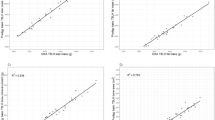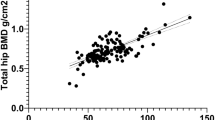Abstract
Objective: To compare in-vivo composition analysis between two dual energy X-ray absorptiometers, a DPX and a DPX/L, from the same manufacturer (LUNAR), pre(Study A) and post(Study B) hardware changes on both absorptiometers.
Design: Comparison of (1) quality assurance (QA) data: air-counts low (38 keV), air-counts high (70 keV), air-counts ratio, percent spillover, R-delrin; and (2) total body compartments: total body tissue (TBTISS), total body fat (TBF), percent total body fat (%TBF), total body lean (TBLEAN), total body bone mineral content (TBBMC) and total body bone mineral density (TBBMD), between the two absorptiometers.
Setting: Centre for Bone and Body Composition Research, University of Leeds.
Subjects: Study A, 14 normal subjects and Study B, a different cohort of 19 normal subjects, were scanned on both machines on the same day.
Results: In Study A, large significant differences were observed in the QA parameters between the two machines. The DPX, air-counts low and air-counts high, being 25% and 22% lower than the DPX/L. The Bland–Altman method of analysis indicated that the DPX was significantly higher for TBTISS (0.3 kg), %TBF (2%) and TBF (1.4 kg) and correspondingly lower for TBLEAN (−1.0 kg). No significant difference was observed in TBBMC. After the hardware changes (Study B) a marked reduction in the differences in QA air-counts was observed. The DPX air-counts low was now 1% higher and air-counts high 8% lower than the DPX/L. The DPX had now only small significant negative differences for %TBF (−0.6%) and TBF (−0.4 kg) and a small significant positive difference for TBLEAN (0.4 kg), compared to the DPX/L. TBBMC difference although slightly increased, was still non-significant.
Conclusions: The closer agreement observed in the QA parameters after the hardware changes was associated with a reduction in the mean differences, 95%CI of the mean differences and limits of agreement of the comparison of body composition analysis from the Lunar machines using the Bland–Altman method. The study indicates that the QA limits set for bone mineral analysis may require more stringent limits for body composition.
Sponsorship: The study was supported by funding from the Medical Research Council, the University of Leeds and the United Leeds Teaching Hospitals Special Trustees.
This is a preview of subscription content, access via your institution
Access options
Subscribe to this journal
Receive 12 print issues and online access
$259.00 per year
only $21.58 per issue
Buy this article
- Purchase on Springer Link
- Instant access to full article PDF
Prices may be subject to local taxes which are calculated during checkout
Similar content being viewed by others
Author information
Authors and Affiliations
Rights and permissions
About this article
Cite this article
Oldroyd, B., Truscott, J., Woodrow, G. et al. Comparison of in-vivo body composition using two Lunar dual-energy X-ray absorptiometers. Eur J Clin Nutr 52, 180–185 (1998). https://doi.org/10.1038/sj.ejcn.1600537
Received:
Accepted:
Published:
Issue Date:
DOI: https://doi.org/10.1038/sj.ejcn.1600537
Keywords
This article is cited by
-
Regional Body Composition: Cross‐calibration of DXA Scanners—QDR4500W and Discovery Wi
Obesity (2010)
-
Cross-calibration of GE/Lunar pencil and fan-beam dual energy densitometers—bone mineral density and body composition studies
European Journal of Clinical Nutrition (2003)



